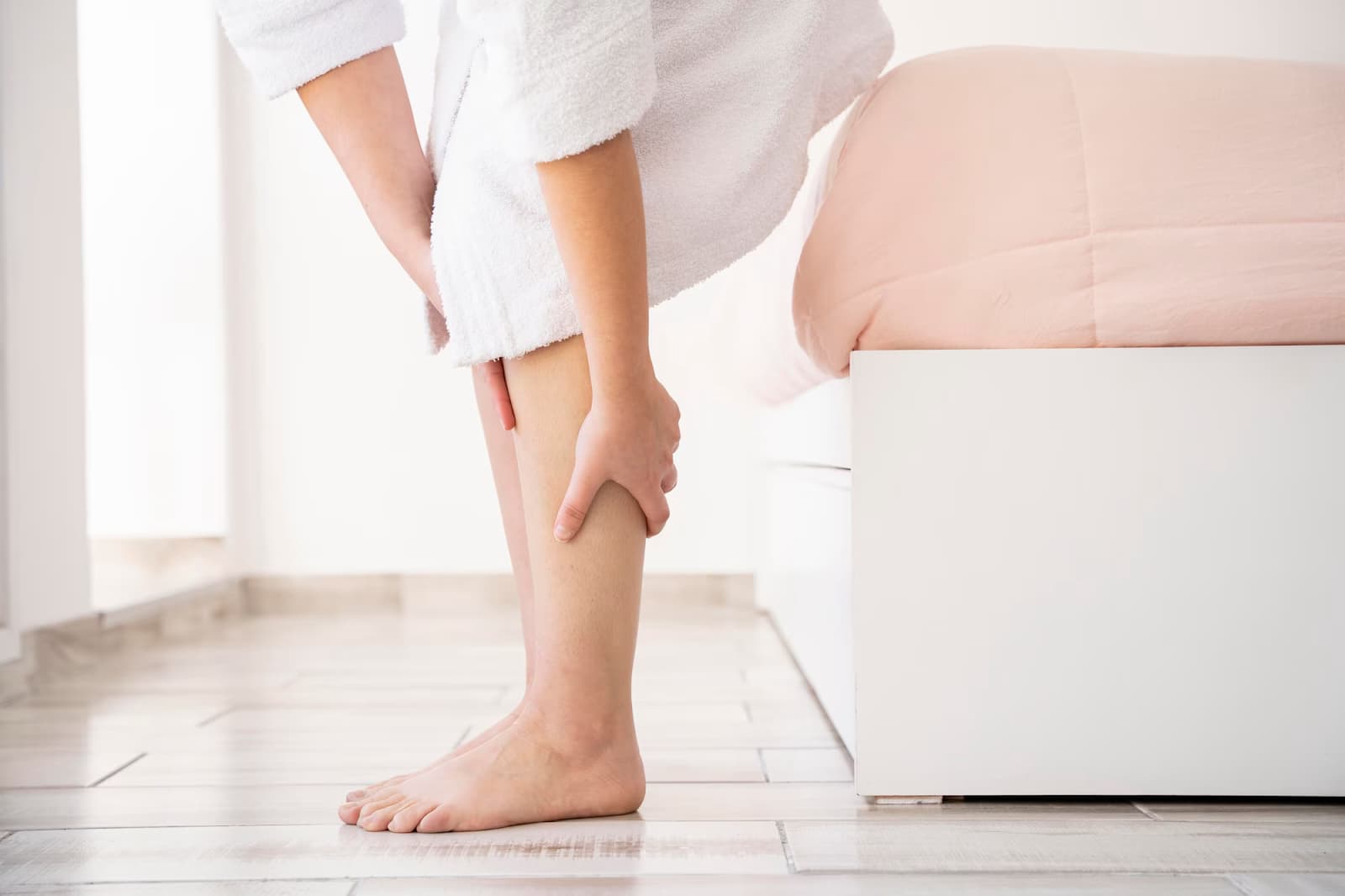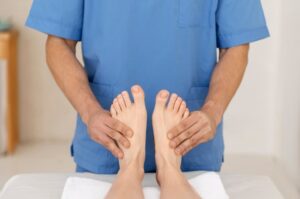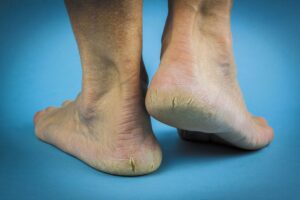Do you find yourself struggling with aching legs that disrupt your sleep at night? The discomfort of leg pain can be a common yet distressing issue that many individuals face. It’s essential to address these symptoms rather than endure them, especially when they interfere with your quality of rest. Your legs bear the weight of your body all day long, making it crucial to identify and alleviate any pain or discomfort that arises, particularly during nighttime hours. Symptoms like stabbing pain, dull aches, or tingling sensations in the legs often indicate underlying problems that require professional evaluation and treatment by experts such as podiatrists.
Key Issues Discussed in the Article:
- Musculoskeletal Pain: Exploring various musculoskeletal issues contributing to leg pain at night, such as muscle cramps, and providing preventive measures;
- Restless Leg Syndrome (RLS): Understanding RLS as a neurological disorder affecting sleep quality and discussing lifestyle modifications to alleviate symptoms;
- Circulation Pain: Addressing circulatory issues like Peripheral Artery Disease (PAD) and Deep Vein Thrombosis (DVT) that can cause nighttime leg pain, along with risk factors and lifestyle recommendations;
- Medical Conditions: Discussing conditions like Sciatica and Osteoarthritis as potential causes of nighttime leg pain, highlighting symptoms and management strategies.
By addressing these key issues, the article aims to provide insights into the causes of leg pain at night and offer practical suggestions for managing and seeking appropriate treatment for these discomforts effectively.
Musculoskeletal Pain
Musculoskeletal pain refers to discomfort or pain affecting the muscles, bones, ligaments, tendons, and nerves. When it comes to experiencing leg pain at night, several musculoskeletal issues could be contributing to your discomfort. Understanding these potential causes is crucial for effective management and relief.
Cramps
One common cause of leg pain at night is muscle cramps. These sudden, involuntary contractions can be triggered by various factors, including muscle fatigue and dehydration. Cramps often occur during periods of restlessness or when changing positions in bed, leading to muscle spasms and discomfort.
To prevent cramps, ensure adequate hydration and electrolyte balance in your body. Incorporating stretching exercises into your daily routine can also help relax muscles and reduce the likelihood of cramping episodes. Additionally, maintaining good posture and avoiding prolonged periods of immobility can minimize the risk of muscle cramps disrupting your sleep.
Preventive Measures for Muscle Cramps
| Preventive Measures | Description |
|---|---|
| Stay hydrated | Drink sufficient water throughout the day to maintain proper hydration levels. |
| Stretch regularly | Perform gentle stretching exercises to promote muscle flexibility and prevent cramping. |
| Maintain good posture | Practice proper body alignment to reduce strain on muscles and decrease the risk of cramps. |
| Avoid prolonged immobility | Take breaks from sitting or standing for extended periods to prevent muscle stiffness and cramping. |
Restless Leg Syndrome (RLS)
Restless Leg Syndrome (RLS) is a neurological disorder characterized by an irresistible urge to move the legs, often accompanied by uncomfortable sensations. Individuals with RLS may experience symptoms predominantly at night, leading to sleep disturbances and daytime fatigue.
If you suspect you have RLS, consult a healthcare provider for a proper diagnosis and treatment plan. Lifestyle modifications, such as regular exercise, maintaining a consistent sleep schedule, and avoiding stimulants before bedtime, can help alleviate RLS symptoms and improve sleep quality.
Lifestyle Modifications for Restless Leg Syndrome
- Engage in moderate exercise regularly;
- Establish a relaxing bedtime routine;
- Limit caffeine and alcohol consumption in the evening;
- Use heat or cold therapy to soothe leg discomfort before sleep.
Lorem ipsum dolor sit amet, consectetur adipiscing elit. Sed eget ultricies neque. Nulla facilisi. Phasellus ac arcu nec justo interdum tincidunt. Curabitur vehicula, libero sed luctus vestibulum, turpis ante fermentum nisi, id volutpat velit odio et est.
Circulation Pain
Circulatory issues can also contribute to leg pain at night, affecting blood flow and causing discomfort in the lower extremities. Understanding the role of circulation in leg health is essential for identifying and addressing potential concerns.
Peripheral Artery Disease (PAD)
Peripheral Artery Disease (PAD) is a circulatory condition that occurs when narrowed arteries restrict blood flow to the limbs, particularly the legs. Symptoms of PAD may include leg pain, cramping, numbness, or weakness, which often worsen during periods of rest or at night.
If you experience persistent leg pain or other symptoms suggestive of PAD, seek medical evaluation promptly. Treatment for PAD typically involves lifestyle changes, medication, and in severe cases, surgical interventions to improve blood flow and alleviate discomfort.
Risk Factors for Peripheral Artery Disease
| Risk Factors | Description |
|---|---|
| Smoking | Tobacco use increases the risk of arterial narrowing and impairs blood flow to the legs. |
| Diabetes | Uncontrolled diabetes can damage blood vessels and lead to circulatory problems in the lower extremities. |
| Hypertension | High blood pressure contributes to arterial damage and reduces blood flow to the legs, increasing PAD risk. |
| Sedentary Lifestyle | Lack of physical activity weakens circulation and promotes arterial blockages, predisposing individuals to PAD. |
Deep Vein Thrombosis (DVT)
Deep Vein Thrombosis (DVT) is a serious circulatory condition characterized by blood clot formation in deep veins, commonly in the legs. DVT can lead to leg pain, swelling, and warmth, with symptoms often worsening when lying down or at night.
If you suspect you have DVT, seek immediate medical attention to prevent complications such as pulmonary embolism. Treatment for DVT typically involves blood-thinning medications, compression therapy, and lifestyle modifications to reduce clot formation and improve circulation.
Lifestyle Recommendations for Deep Vein Thrombosis Prevention
- Maintain a healthy weight through diet and exercise;
- Avoid prolonged periods of immobility, especially during long flights or car rides;
- Elevate your legs periodically to promote blood flow and reduce swelling;
- Wear compression stockings as recommended by healthcare providers.
Lorem ipsum dolor sit amet, consectetur adipiscing elit. Sed eget ultricies neque. Nulla facilisi. Phasellus ac arcu nec justo interdum tincidunt. Curabitur vehicula, libero sed luctus vestibulum, turpis ante fermentum nisi, id volutpat velit odio et est.

Medical Conditions
In addition to musculoskeletal and circulatory factors, certain medical conditions can contribute to leg pain at night, requiring specialized evaluation and management strategies to address underlying health issues effectively.
Sciatica
Sciatica is a condition characterized by pain that radiates along the sciatic nerve, typically affecting one side of the body. Common symptoms of sciatica include sharp, shooting pain in the lower back, buttocks, and legs, which may worsen during nighttime hours or with specific movements.
If you suspect you have sciatica, consult a healthcare provider for a comprehensive assessment and treatment plan. Treatment for sciatica may involve pain management strategies, physical therapy, and in some cases, surgical interventions to relieve nerve compression and alleviate symptoms.
Common Symptoms of Sciatica
| Symptoms | Description |
|---|---|
| Sharp, shooting leg pain | Radiating pain along the sciatic nerve, often extending from the lower back to the legs. |
| Numbness or tingling sensation | Loss of sensation or abnormal sensations like pins and needles in the affected leg. |
| Muscle weakness | Reduced strength or control in leg muscles, leading to difficulties with movement or coordination. |
| Worsening pain with movement | Increased discomfort when walking, standing, or performing activities that engage the lower back and legs. |
Osteoarthritis
Osteoarthritis is a degenerative joint disease that can affect various joints in the body, including those in the legs. Individuals with osteoarthritis may experience nighttime leg pain due to inflammation, cartilage damage, and joint stiffness, impacting mobility and sleep quality.
If you have osteoarthritis-related leg pain, consult a healthcare provider for an accurate diagnosis and personalized treatment plan. Management of osteoarthritis typically involves a combination of medication, physical therapy, lifestyle modifications, and possibly surgical interventions to alleviate pain and improve joint function.
Management Strategies for Osteoarthritis-Related Leg Pain
- Use hot or cold therapy to reduce inflammation and ease joint discomfort;
- Engage in low-impact exercises to strengthen muscles and improve joint flexibility;
- Maintain a healthy weight to reduce stress on weight-bearing joints like the knees and hips;
- Consider assistive devices or orthotic supports to enhance mobility and reduce joint strain.
Lorem ipsum dolor sit amet, consectetur adipiscing elit. Sed eget ultricies neque. Nulla facilisi. Phasellus ac arcu nec justo interdum tincidunt. Curabitur vehicula, libero sed luctus vestibulum, turpis ante fermentum nisi, id volutpat velit odio et est.
Conclusion
In conclusion, experiencing leg pain at night can significantly impact your overall well-being and quality of life. By understanding the diverse causes of nighttime leg pain, from musculoskeletal issues to circulatory problems and underlying medical conditions, you can take proactive steps to manage symptoms effectively and seek appropriate medical care when needed. Prioritizing self-care practices, seeking professional guidance, and adopting healthy lifestyle habits are essential components of managing leg pain and promoting optimal leg health. Remember, persistent or severe leg pain warrants prompt evaluation by healthcare professionals to address underlying issues and enhance your comfort and mobility.
Lorem ipsum dolor sit amet, consectetur adipiscing elit. Sed eget ultricies neque. Nulla facilisi. Phasellus ac arcu nec justo interdum tincidunt. Curabitur vehicula, libero sed luctus vestibulum, turpis ante fermentum nisi, id volutpat velit odio et est.


